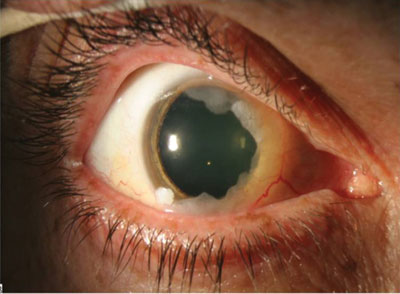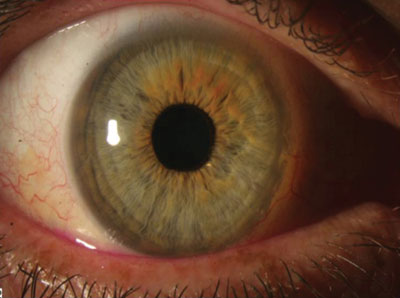Interferon injections may resolve ocular surface squamous neoplasia
The same drug is used for hepatitis and cervical cancer.
 Carol L. Karp |
Interferon injections resolved tumors in patients with primary or recurrent ocular surface squamous neoplasia, with only one relapse reported among 15 eyes after extended follow-up, according to a study.
Even though interferon has been used to manage diseases such as malignant melanoma and cervical dysplasia, its use in ocular surface squamous neoplasia (OSSN) is considered off-label, lead study author Carol L. Karp, MD, told Ocular Surgery News. Dr. Karp became familiar with the drug when she was seeing hepatitis patients as part of Schering-Plough’s clinical trials for interferon alpha-2b.
“I started looking into the literature and saw that it was also used for cervical cancer, which is quite similar to conjunctival OSSN, and decided to write a protocol for the [institutional review board] to try it,” she said.
Results of the study were published in Ophthalmology.
Patients, procedures
Patients with OSSN received 0.5-mL injections of 3 million IU interferon alpha-2b until their tumors resolved, according to the chart review of 15 eyes of 14 patients.
Ten patients were older than 60 years of age, and the median pre-treatment lesion area was 32 mm. The authors noted that lesions of any size can be treated, but larger lesions require more injections.
 Patient with annular ocular surface squamous neoplasia, biopsy proven. Images: Karp CL |
 Resolved ocular surface squamous neoplasia after five subconjunctival injections. |
Dr. Karp said that she chose the initial dosage, administered three times weekly, because it was known to be safe and effective in patients with hepatitis. However, the number of injections was reduced to once weekly or once every 2 weeks to better accommodate the patients’ schedules.
Although interferon alpha-2b is available as a topical eye drop, this method has a lower compliance rate because it requires more frequent, extended use and is costlier. The injections are available commercially and do not require additional compounding, making them more accessible to patients, Dr. Karp said.
“Patients can get the prescription filled at a local pharmacy … and thus the costs are generally much lower since they can get it with their insurance and use only a co-pay,” she said.
Despite the benefits of interferon injections, systemic use of interferon alpha-2b — whether administered intravenously, intramuscularly or subcutaneously — has been shown to cause fever, malaise and flu-like symptoms. In this study, five patients (33%) experienced systemic side effects, which diminished with subsequent injections.
Patients were also given 1,000 mg of acetaminophen immediately after the injections, as well as every 4 hours as needed to reduce the flu-like symptoms.
Study outcomes
Follow-up was conducted every 3 months for the first year, every 6 months in the second year and every year thereafter, with a median follow-up time of 55 months.
Thirteen of 15 eyes experienced complete tumor resolution, with a median of six interferon alpha-2b injections and a 1.4-month median resolution time.
 Patient with ocular surface squamous neoplasia receiving subconjunctival injection of interferon alpha-2b. |
The two eyes that did not respond to interferon alpha-2b injections were treated four times daily with topical mitomycin C 0.04%, and the tumors resolved in both eyes after 2 weeks. However, one eye experienced disease recurrence after 4 months and was treated successfully with two additional cycles of mitomycin C 0.04%, the authors said.
Interferon alpha-2b injections can be used for both primary and recurrent OSSN, Dr. Karp said. She considers multiple factors before committing to one treatment protocol.
“When I see a patient with recurrent OSSN, I think about all the treatment options available: surgery, interferon, mitomycin C or 5-fluorouracil,” she said. “Any one of them can be a viable option.”
Dr. Karp then tailors the treatment to the needs of the patient, taking into consideration cost, compliance and other factors.
Future research
Although the current study included only a small number of patients, Dr. Karp said she has observed the same success in those treated since 2007 — about 15 patients with injections and about 30 patients with drops.
She continues to use once-weekly 0.5-mL injections of 3 million IU of interferon alpha-2b. However, more research is needed to determine the most effective treatment regimen, as well as the need for concomitant topical therapy, the authors said.
Dr. Karp intends to use the results of this study as a guideline for future research.
“We will be looking at our data on this cohort in the future to try to evaluate the ideal dose and frequency needed for the best response,” she said. – by Courtney Preston
Reference:
- Karp CL, Galor A, Chhabra S, et al. Subconjunctival/perilesional recombinant interferon a2b for ocular squamous neoplasia: A 10-year review. Ophthalmology. 2010;117(12):2241-2246.
- Carol L. Karp, MD, is a professor of clinical ophthalmology and can be reached at the Bascom Palmer Eye Institute, 900 NW 17th Street, Miami, FL 33136; email: ckarp@med.miami.edu.
- Disclosure: Dr. Karp has no relevant financial disclosures.

![]()
 Amar Agarwal |
The authors have shown the outcome of subconjunctival interferon alpha-2b in ocular surface squamous neoplasia (OSSN). Overall, the study has been presented and documented well. Nevertheless, future trials with a larger population and longer follow-up are required to confirm the long-term effects, recurrence rate, cost-effectiveness and compliance of this method of drug delivery. The take-home message from the article is that the perilesional subconjunctival interferon alpha-2b can be used as an alternative therapy in primary or recurrent OSSN treatment. The lack of compliance and cost of drops have been the limitations for topical medications. Moreover, excision and cryotherapy of limbal mass may lead to stem cell defect. Thus, subconjunctival interferon alpha-2b can be practiced in patients who lack compliance for topical treatment. However, follow-up is required in these patients as interferon can cause flu-like symptoms.
– Amar Agarwal, MS, FRCS, FRCOpth
OSN
Asia-Pacific Edition Board Member
Disclosure: Dr. Agarwal has no relevant
financial disclosures.
